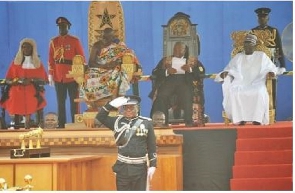 The Presidential Seats on display. Photo: Daily Graphic
The Presidential Seats on display. Photo: Daily Graphic
Since independence, all presidents, from Osagyefo Kwame Nkrumah to Nana Addo Dankwa Akufo-Addo and all the other Heads of State of Ghana, were sworn into office, and immediately placed on a seat that carries a lot of significance as well as mysteries.
A year ago today, GhanaWeb published this article, which focuses on some of the mysteries surrounding the seat of government.
Read the full details of the story as published by GhanaWeb on Thursday, May 12, 2022, below:
When Kwame Nkrumah, Jerry John Rawlings, John Agyekum Kufuor, John Evans Atta Mills, John Dramani Mahama, Nana Addo Dankwa Akufo-Addo, and all the other Heads of State of Ghana were sworn into office, they were immediately placed on a seat that carries a lot of significance as well as mysteries.
The Presidential Seat of Ghana and its cousin, the State Sword, have been symbolic emblems of Ghana’s history since the days of Kwame Nkrumah but the stories behind these seats have not been as profound.
In this research article, GhanaWeb highlights the real, traditional names of the three Presidential Seats of Ghana, as well as that of the State Sword that have become synonymous with the presidency.
Let’s first bring you the names of these seats:
According to a research paper titled, “Ghana’s Presidential Seats and Sword of State: Aesthetic Manifestation of Kwame Nkrumah’s Cultural Policy on Ghana’s Political Culture,” and written by Jerry Orhin Yorke, it described the three Presidential Seats and the State Sword as the Chair of State (Asipim), the Seat of State (Asεsεgua) now referred to as The Presidential Seat, and The Vice-President’s Seat (Asipim).
History of the Presidential Seat:
Before independence, all governors of the various British colonies who ruled as representatives of the Queen of Britain had ceremonial chairs molded after the throne of the queen.
It was on these chairs that the governors of the various colonies sat during meetings with the local assemblies and each of them had the backrest and armrest like the Asipim chairs used by traditional rulers of Southern Ghana.
When Kwame Nkrumah gained freedom for Ghana, he ordered for seats that combined the best ideas of the governor’s chair and that of the traditional rulers of the southern part of Ghana for his use.
It was from this integration and modernization that the Asεsεgua and the Asipim were designed, becoming what is now referred to as the Presidential Seats.
They were designed by Kofi Antubam, a Ghanaian artist and designer whose works of art depict understated aspects of community life in Ghana.
The symbolisms of the Presidential Seat:
Also known as the Seat of State, the Presidential Seat is made up of various adinkra symbols, as well as some borrowed ideas.
The seat is carved in wooden but overlaid with gold - to symbolize the life and sovereignty of Ghana, and is made up of adinkra symbols including the Osramfa, Okosuasu, Kontonkurowi, Kuntinkantan or Anantwurom, Aborobe, Dadebene or Ahokera wo, Abankuo, Ghana Soroma-Bire, Ananum, Puruw, Ananum, Owo-Koforo-Adobe, Akosane (Dame-Dame), Krapa (MusuYide) and Nkyinkyim.
In designing the Asεsεgua, it was expected to “represent some of the basic communal principles which have guided the lives and activities of the Ghanaian society throughout the ages.”
The original design of the Asεsεgua included flat wooden wings at both sides of the arm-rest but these were removed. And to aid its movement, the design of the Asεsεgua consisted of three pieces which fit into each other to make the seat. For the purposes of this discussion, the researcher divided the Seat of State into three (3) parts. The back rest forms the first part, the Asεsεgua forming the second part with the Foot Stool and the base of the Asεsεgua forming the third part.
The seat also invokes not only African pre-colonial emblems of power, but also European aristocratic imagery. The upper part, and the arm rests which are topped with small golden crowns, are designed like a British monarch’s throne.
The Vice President’s Seat (Asipim):
According to Jerry Orhin Yorke, although it is currently being used as the Vice President’s Chair, it is recorded that Dr. Kwame Nkrumah used this chair at different sittings at Parliament House when he was president.
Just like the Presidential Seat, this chair has almost all the adinkra symbols found on the other chairs and in terms of size, it is the smallest of the three State Seats.
It is also gold-plated with pure gold, as is the others, but this chair has no foot rest.
The back rest of this chair is without any superimposition of an Adinkra symbol but is rendered in a plain navy blue colour, and resting on it are two eagles with their feet supporting the Adinkra-Hene (a traditional Ghanaian three-circled symbol of sovereignty) with Krapa (MusuYide) symbol of wisdom and knowledge, superimposition of Krapa symbol at the centre.
The excessive use of the Owo-Koforo-Adobe (zigzag motif) which symbolises the exercise of wisdom in human relationships is an indication of what is expected of its occupants.
On the inner sides of the extended flat legs that support the armrests are two black stars carved in a circle.
Share your news stories and ideas with GhanaWeb

To advertise with GhanaWeb

Meanwhile, watch the latest episode of People and Places on GhanaWeb TV below:
NW/OGB